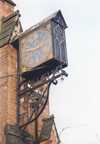Sneinton St ChristopherClock

St Christopher’s has a public clock located on the buttress of the south
transept wall, and therefore in full view from the parallel road. It is a large
double-faced clock, each of the faces being about 30" in diameter, set within
a square case. The spandrels are decorated with a pair of stylised leaves set
at right angles to each other with a squared floral boss joining the two and
filling the corner. Currently, plastic sheeting protects both faces. The faces
are coloured light blue, with gold Roman numerals and chapter ring. The clock
hands are plain without decoration or piercing, they are also gold coloured
The case is about twelve inches thick, protected by a low-pitched roof. An
end panel with applied tracery decoration completes the case.
The clock is supported by a very substantial wrought iron bracket, which has
both curved, and diagonal cantilevers connecting it to the wall-plate and the
gabled stonework of the buttress. A number of designs are incorporated into
the ironwork including trefoils and quatrefoils, fleur-de-lys and gilded bosses
as on the clock face.
It is thought that the clock was originally installed sometime during the
late 1920s or early 1930s. Gents of Leicester manufactured the
type of electrical drive mechanism known to drive the original clock about
that time. It had wet-cell batteries to maintain timekeeping in the event of
a power failure. Electricity was installed into the church in 1927/8. Gents
of Leicester maintained the clock for many years. Mr Derek Lymn, who currently
maintains the clock on behalf of the Nottingham City Council, suggests that
the case was designed and made by former local clock specialist G and F Cope.
(Mr Lymn was an apprentice at Copes.) He claims that many years ago the clock
case carried Cope’s name. If so, it is no longer apparent.
There is no record of the clock being damaged or repairs being carried out
after the 1941 bombing. No expenditure in this respect is itemised in the rebuilding
and refurbishment invoices. Being outside the building it may have escaped
without damage, although its power supply would have been destroyed by the
internal fire putting it out of action for several years.
The clock was last renovated in 2003. This included the installation of a
modern electrical drive mechanism, which moves the hands one minute at a time.
It is now designated a public clock in the care of the Nottingham City Council.
|